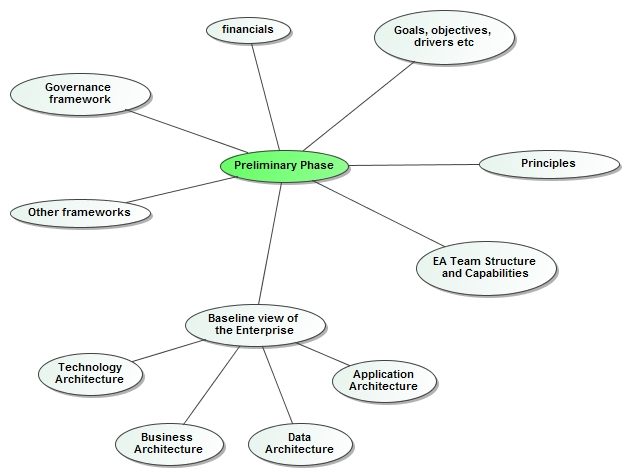Preliminary Phase
Introduction
For certain topics when trying to understand TOGAF®, we reference specific documents as a means of explaining concepts. Here, you can locate the concept and the associated document(s)
Executing the preliminary phase gives the organisation the opportunity to establish a number of norms
- define the architecture team
- define the scope of the architecture teams work, in other words their mode of engagement
- harvest the organisations current estate into an architecture repository that can later be used in other architectural activities
- specify and create a governance framework
- define how the architecture team will do architecture in the organisation
- specify and create sets of architecture principles
In order to successfully complete the preliminary phase, using the resources that are available to them, the architecture team must baseline the enterprise as defined in the initial scoping exercise. In order to do this they should examine the enterprises business, data, application and technology domains (in no specific order). This is a mammoth tasks that could take months if not a few years to complete. In reality, very few organisations will grant such as wish to a newly formed architecture capability. So a new challange exists! How do we basline the enterprise without the ability to do a full preliminary phase.
You can't change what you don't know...
The danger of spending months if not years executing the preliminary phase is that the architecture team may become an irrelevance to the organisation. You have to be seen to be adding value to the organisation. Spending all your time in an ivory tower harvesting the estate and then pushing out policy documents, won't wash and put you good stead with the decision makers!!!
So you could
- bring in an external organisation on a short basis to harvest and baseline your estate. Lets say no more than 6 months work with some very clear KPI and CSFs.
- settle in with the team if one has been established, harvest the estate and build up the baseline with each piece of work you are engaged in, repeat this process for each engagement. This is practical and works. Know one expects you to do your job without going through a process of discovery.
Collateral
Let's see some of the key activities of the Preliminary Phases
| Establish the scope of the architecture function | Understand exactly why you exist. Be very careful you don't become an irrelevance to the organisation. Experience shows three modes of engagement
|
| Define the enterprise | It's vitally important that at the architecture function know its scope of engagement. Which organisational units come under its auspice. Where can the architecture function spend time investigating. Not all organisational units will be pleased with this new function prying into its affairs, into its business as usual model, so top level support is crucial. |
| Establish the governance framework | Enterprise Architecture cannot work without good governance. Two governance frameworks need to be established early in the function setup, an EA governance and an implementation governance framework. |
| Define Principles | Good principles are an integral part of the EA governance framework. Principles ensure sound strategic decision making. Establish them early. |





